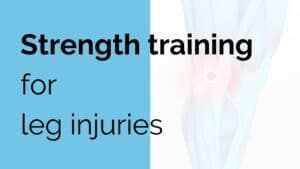In This Article
The benefits of strength training are one of the most well researched and well known in the sporting world.
How to integrate the benefits of strength training into your existing routine, or how to design a strength program for a specific goal, is a different story.
We’ve written a number of posts covering how to add strength training to your running program, how to design a strength program for a leg injury and so much more.
What are the 6 benefits of strength training?
There are so many benefits of strength training that it’s difficult to narrow the list down. But if we had to choose the six biggest benefits, we’d go with:
- More muscular force and power
- Better control of technique
- Increased muscle efficiency (less energy needed to produce force)
- Reduces muscle fatigue during sport
- Reduces injury risk
- Improves consistency of training (less recovery time required and breaks from injury)
Why is strength important in life?
The benefits of strength are more than just lifting weights in a gym!
Strength can provide increased capacity for everyday tasks so you’re less fatigued by normal activities. That can help with recovery after training sessions and to feel better overall.
It means you have better control of movement, which makes the task feel easier. It also causes less irritation to tendons, cartilage and other soft tissues. That increases your protection from injuries.
How does strength training help you in daily life?
The most obvious benefit of strength training is that it increases your muscle’s capacity to generate force, so you can move faster with more power.
Another benefit of strength training is that it gives you better control of your technique. That means that there’s less wasted energy and effort, making you more efficient.
Strength training also means that you can work hard for longer, as it delays muscle fatigue.
One of the biggest benefits of strength training is an often forgotten one – it reduces your risk of injury with better control of movement and more resistance to fatigue.
Why is strength training important for athletes?
Athletes have an almost singular focus on performance.
Performance is delivered by having alignment between technique, fitness and strength. When all three elements have reached full potential, your performance will follow.
Of the three components above, strength delivers performance in multiple ways and enhances the effect of the other two components.
It improves technique – strength provides the capacity to control and optimise technique and efficiency.
It improves fitness – strength helps avoid fatigue and injury to allow more consistent fitness training without recovery or injury breaks.
What are the different types of strength training?
Strength training is a term used to describe any resistance training. However there’s several different aims and types of training within the category.
Each sub-category of strength training involves tweaking specific parameters of the training, rather than being a completely different set of movements.
Building strength is the main sub-category within the group. It involves working against resistance to generate fatigue within 8-12 reps. It improves the amount of force your muscles can produce.
Endurance training is about working on muscles producing force for a longer period of time and/or accruing less fatigue. It tends to aim for fatigue within 15+ reps.
Power training is about the speed of the force generation – it’s about producing force quickly. The main parameter for power is the speed of force production, however most power exercises will generate fatigue within 6-8 reps.
Plyometric exercises are focused on improving tendon bounce and elasticity. They’re faster movements with some bouncing or recoil component. The reps on a plyo exercise usually depend on the ability of the muscles to brace the movement – if those muscles fatigue and can’t brace, the tendons no longer get effectively loaded.
Hypertrophy is focused on building muscle bulk (ie. bodybuilding). It’s worth a mention as a sub-category, although it’s rarely used during the injury recovery phases or for running performance.
What age can you start strength training?
There are benefits of strength training from 14 years and up, with the benefits of strength really ramping up after 16 years.
This is due to the body’s levels of certain hormones that build muscle and not related to safety.
Kids aged 12 years old won’t have the necessary levels of growth hormones to build muscle or see a big change in strength.
However it’s a great idea to get kids into strength training from 12 years old, so they can learn the techniques and focus on form before they start just chasing “the gainz”.




Comments are closed.